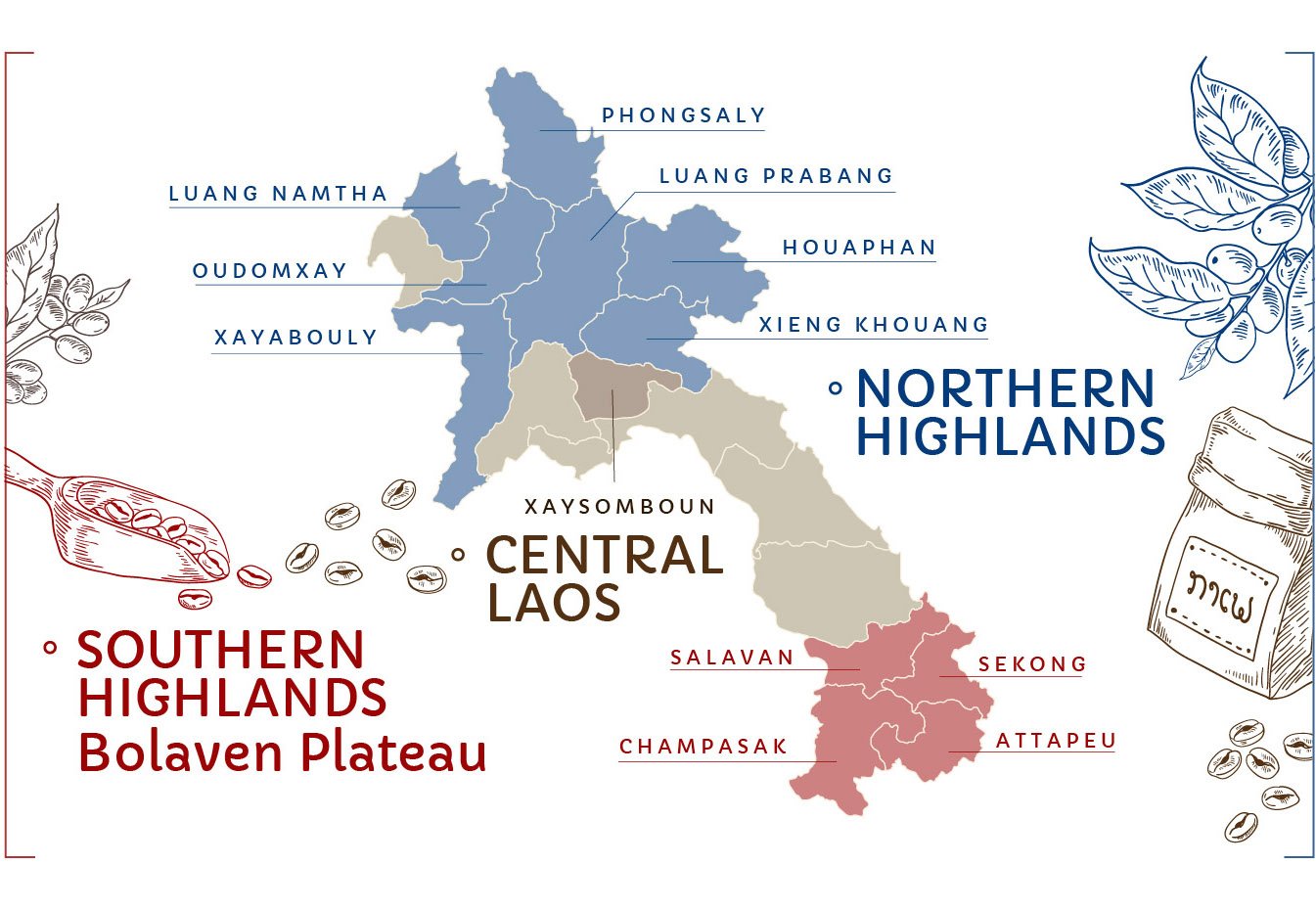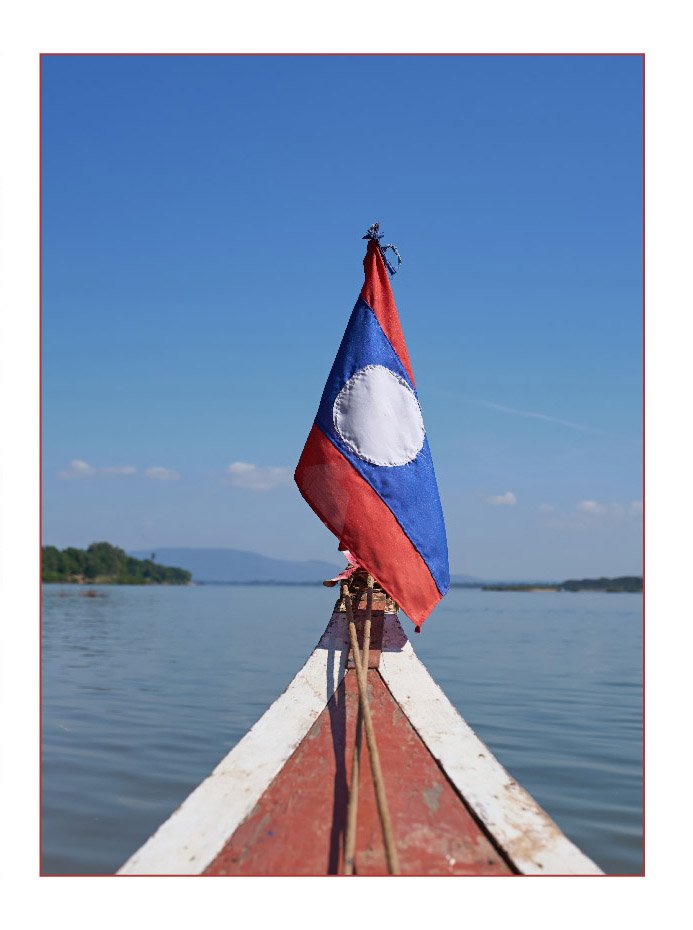Coffee in Champasak Province
Champasak in the southern highlands is prime coffee-growing country, thanks to the rich, ancient soils and unique climate of the Bolaven Plateau.
The province enjoys a monsoon climate, with a rainy season from May to November and a dry season from December to April. Cooler highland temperatures, adequate rainfall and mist during the wet season promote the slow maturation of coffee cherries, enhancing flavour profiles.
The rains trigger the flowering of coffee plants which typically begins in March. Blooms of fragrant white flowers mark the start of a new production cycle, which varies slightly depending on regional microclimates.
November marks the start of the coffee season, when the plateau’s volcanic soil, moderate rainfall, and distinct climate create beans with renowned depth and character.
The growth cycle for coffee from flowering to harvest is 6–8 months for Arabica and 8–11 months for Robusta.
Case Study – Yrou Coffee, Champasak
Founded by Ketmany Phosavanh, a young female Q grader, Yrou Coffee partners with Hmong and Khmu farmers to produce shade-grown specialty Arabica in the Bolaven Plateau, near Paksong.
Yrou Coffee brings three generations of coffee growers together to improve coffee quality and empower ethnic communities. The company distributes free coffee seedlings to farmers and trains them in sustainable practices. Locally roasted beans are tailored for high-end markets, ensuring quality and traceability.
Ketmany Phosavanh is the first Lao women certified Q Grader. A Q Grader is a highly skilled coffee professional, certified by the Coffee Quality Institute (CQI) in California, to evaluate and grade coffee quality. Q Graders are taught to develop exceptional sensory skills to detect subtle flavours and aromas in coffee, and their assessments can significantly influence coffee pricing and market value.
Ketmany is helping Yrou Coffee to position itself as a leader in Laos' evolving coffee industry.
Yrou Coffee, owned and run by Ketmany Phosavanh, Laos' first female certified Arabica Q Grader, connects three generations of coffee growers and promotes ethical farming. Photo by Nicole Motteux
Coffee Origin Highlight
Pakse: Gateway to Southern Laos’ Coffee Country
Founded in 1905 as a French administrative centre, Pakse is a key commercial hub in southern Laos, linking the Mekong and Xe Don rivers with coffee traders from the Bolaven Plateau and neighbouring Thailand, Vietnam, and Cambodia.
An hour’s drive from Pakse, rising from the Mekong, meets the Bolaven Plateau and the journey into Laos’ coffee heartland begins. The road to Paksong, the coffee capital of the southern highlands, is dotted with kilometre markers guiding traders and visitors alike.
At kilometre 34, the Coffee Research Centre supports the industry with training and a nursery. It has panoramic views over a deep valley shaped by ancient volcanic activity and winding rivers. In the distance, an arm of the Bolaven Plateau forms a steep, tree-covered escarpment, rising sharply from the valley. Far away, the Mekong River appears as a faint ribbon of water, its gentle bend just visible.
Further along, at kilometre 40, cafés like CPC Coffee Shop serve freshly brewed coffee, and Lak 40 has three generations of coffee growers serving specialty roasts. Jhai Café offers locally sourced brews, while CC 1971 Café reinvests its profits into education and clean water projects from a retrofitted bombed-out building. Le Deux Soeurs Café, on the outskirts of Paksong, is run by two young sisters, serving a delicious cakes and freshly brewed coffee in a beautiful garden setting. Deu Hueng and Miraclelao Coffee factories also mark the landscape.
At 1,300 m elevation is Yrou Coffee, whose female founder is a third-generation grower and one of Laos’ few Q graders. Yrou produces Arabica varieties like Typica, Yellow Caturra, and Catimor, working with local women and ethnic communities.
The Paksong Highland Coffee Estate, set in a traditional Lao wooden home, offers tranquil plantation views and specialty blends.
Visitors can also explore the Bolaven’s stunning waterfalls of Tad Fane, Tad Yuang, and Tad Champee. Or zipline above them for an unforgettable view of the plateau’s lush landscapes and coffee farms.
Visitors enjoy fresh Lao coffee among the fields and flowers at Paksong Highlands in the Bolaven Plateau. Photo by Nicole Motteux
Vat Phou temple complex
Vat Phou, also known as Wat Phu, is a remarkable temple complex in Champasak province, southern Laos.
Some structures are over 1,000 years old, though most are from the 11th–13th centuries and are closely linked to the Khmer Empire of Angkor Wat in neighbouring Cambodia.
Perched on a hillside with six terraces of stone steps lined with frangipani trees, the temple offers magnificent views over the valley and down to the Mekong River.
The scent of frangipani blends with coffee flowers, filling the air with beauty and aroma. Photo by Nicole Motteux.
Champasak’s ancient link to Angkor Wat in Cambodia lies at the foot of the Bolaven Plateau along the mighty Mekong River. Photo by Nicole Motteux















